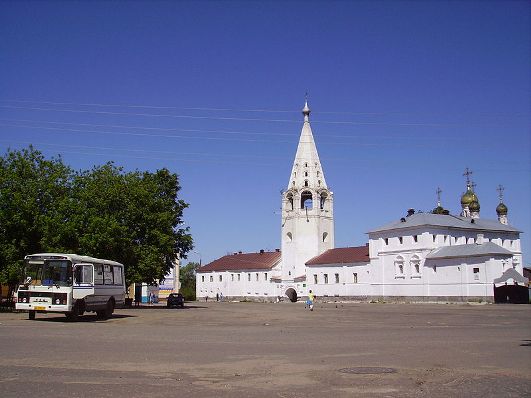

Location: Sovetskaya 5
The Sretensky Convent (Holy Sretensky Monastery) is one of the oldest Orthodox monasteries in the Vladimir region, located in the historic center of Gorokhovets, at 41 Moskovskaya Street, at the foot of Puzhalova Mountain and near the Klyazma River. The convent is an outstanding monument of 17th-century Russian architecture, combining elements of Moscow Baroque and Nizhny Novgorod architecture, and is listed as a cultural heritage site of federal significance. It occupies approximately one hectare, surrounded by a white-stone wall with towers, and includes several churches, a bell tower, and monastic buildings. Today, it is an active convent of the Vladimir Diocese of the Russian Orthodox Church, home to approximately 20 nuns, and attracts pilgrims and tourists with its history, architecture, and tranquil atmosphere. The convent is dedicated to the Feast of the Meeting of the Lord (the Meeting of the Lord), symbolizing the meeting of the Old and New Testaments.
The monastery was founded in 1658 by decree of Patriarch Nikon as a
men's monastery to strengthen Orthodoxy in the region. Initially, all
the buildings were wooden: in 1678, two wooden churches were built
here—the cold Sretensky and the warm St. Sergius churches. Stone
construction began in the late 17th century thanks to donations from
local merchants, particularly Semyon Ershov, who financed the
construction of the Sretensky Cathedral and its three-tiered bell tower
in 1689. In 1700, the heated St. Sergius church was built, and in the
18th century, the monastery expanded with the addition of monastic
buildings and a fence.
During its heyday (late 17th - early 18th
centuries), the monastery was the center of spiritual life in
Gorokhovets, which flourished as a trading town on the route from Moscow
to Nizhny Novgorod. Following Catherine the Great's reform of 1764, it
became a stateless monastery (without state support), but continued to
function. In the 19th century, the monastery owned land and buildings,
including the Shiryaev House (a monument of civil architecture from the
late 17th century), which now belongs to the monastery.
During the
Soviet era, in the 1920s, the monastery was closed, and its buildings
were used as warehouses and workshops. Its revival began in the 1990s:
in 1992, the monastery was returned to the church, and in 1995, it was
converted into a convent. Restoration work continues: in the 2000s, the
bell tower, domes, and interiors were restored, and in recent years, the
fence and buildings have been renovated. Today, the monastery actively
participates in pilgrimage programs and cultural projects in
Gorokhovets.
The monastery's architectural ensemble developed in the late 17th and
18th centuries and represents a harmonious blend of Baroque elements
with traditional Russian architecture. The main buildings are white
stone, with red roofs and golden crosses, creating a striking contrast
with the surrounding landscape.
Sretensky Cathedral (1689): The
central church, dedicated to the Meeting of the Lord and the Vladimir
Icon of the Mother of God. This double-height, five-domed, quadrangle
building with a refectory was built in the spirit of Nizhny Novgorod
architecture of the late 17th century. The facades are decorated with
kokoshniks, architraves, and pilasters; the interior features
18th-century frescoes depicting biblical scenes, a wooden iconostasis,
and relics of saints. The onion-shaped domes are green with golden
stars.
Sergius Church (1700): A warm church adjacent to the
cathedral, dedicated to St. Sergius of Radonezh. This single-domed
structure houses a refectory, modest in decor but with a cozy interior
for winter services.
Bell Tower (1689): A three-tiered tented tower,
approximately 35 meters high, is one of the tallest in Gorokhovets. The
lower tier is the entrance gate, the middle tier is for ringing bells,
and the upper tier is a tent with arches and a clock. The bell tower
dominates the ensemble and is visible from afar.
Monastic Buildings
and Walls: Two-story 18th-century cells connected by galleries and a
white stone wall with towers (18th century), creating a fortress-like
effect. Inside are a garden, a chapel, and outbuildings.
The
monastery's interiors are ascetic: white walls, icons from the 17th–19th
centuries, including the venerated Vladimir Icon of the Mother of God.
The overall style is Baroque, with elements of Classicism in later
additions.
Merchant Contribution: The monastery exemplifies the patronage of
Gorokhovets merchants, such as the Yershovs, whose funds enabled the
construction of a stone complex during the town's heyday.
Panoramic
Location: The grounds offer views of the Klyazma River and the historic
center of Gorokhovets, making it a popular tourist destination on the
Golden Ring.
Sacred Relics: The cathedral houses the relics of saints
and venerated icons, attracting pilgrims. The monastery is renowned for
its icon painting and handicraft traditions.
Legends: Linked to the
history of Patriarch Nikon and the 17th-century church reform.
The monastery is open daily from 8:00 AM to 6:00 PM; services are
held in the morning (8:00 AM) and evening (5:00 PM). Admission is free,
but a donation is recommended. Tours are organized by the monastery or
local museum (cost 200–500 rubles). Getting there: From the center of
Gorokhovets, walk (5–10 minutes from the square) or take a bus/car
(coordinates: 56°12'10"N 42°41'20"E). The tour takes 1–2 hours; rules:
modest clothing, photos with permission. Combine with a visit to other
Gorokhovets attractions, such as the Annunciation Cathedral or the
Yershov House. The best time is summer or holidays (Sretenie, February
15).
Sretensky Monastery is the pearl of Gorokhovets, embodying
Russian history and spirituality, an ideal destination for those
interested in architecture and pilgrimage.